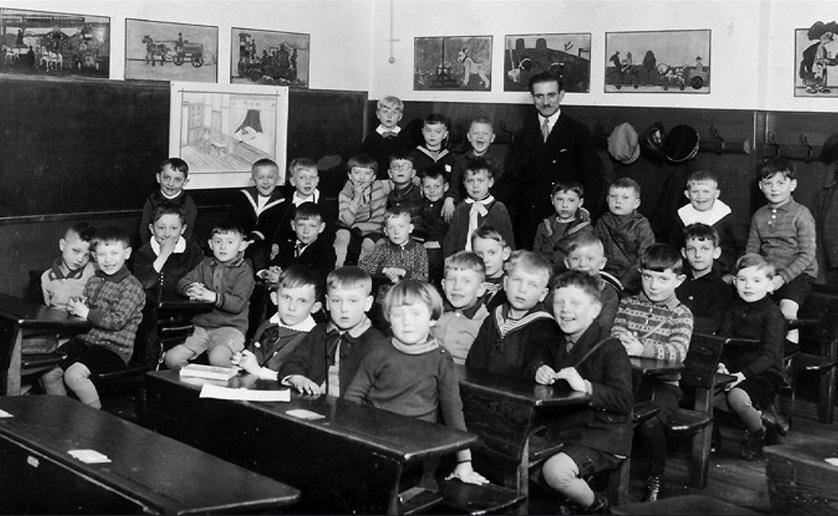
Individual German Schools: Weissensee Volksschule (1935)

Figure 1.--This is a Volksschule primary school class in Weissensee (a district of Berlin) taken in 1935. We would have guessed that they were the youngest children in the school. German children began Volkschule at age 6 years. The source referred to as the second class. If this means the the second year, then the boys would be about 7 years old. The teacher has taken pains to decorate the classroom with images the boys would enjoy. The pictures around the room appear to involve horses and farm animals. Notice the school caps hung on hooks at the back of the room.
|
|
This is a Volksschule primary school class in Weissensee (a district of Berlin) taken in 1935. We would have guessed that they were the youngest children in the school. German children began Volkschule at age 6 years. The source referred to as the second class. If this means the the second year, then the boys would be about 7 years old. The class seems to be only boys. There is a pupil in the first row with rather longish hair. Most boys had their hair cur short for school, but we occassionally see a few boys with longer hair. Several of the boys are wearing sailor suits. Some have white collars and bows. This was becomong less common in the 1930s, but the younger boys still wore them. Here there were probably social class factors involved. Volksschule is interesting because children of all social classess and abilities attended. Germany at the time was still a very class-stratified society. Voksschule was until 1933 virtually the only time and place where Germans from varied class strata intermingled on an equal plane. (With the NAZI take over, Hitler introduced other such expeiences, the Hitler Youth, the Reichsarbietsdienst, and finally the Wehrmacht.) Private schools were not very common and not academically more demanding than state schools. We suspect that the boys with white collars and bows, sailor suits, and longer hair were from more affluent families. They all are wearing short trousers with long stockings (with the traditional Leibchen--bodice and supporters). They look quite happy. Notice the male teacher standing at the back of the class. Most boys had male teachers even in the early primary years. This did not begin to change until World War II. He has taken pains to decorate the classroom with images the boys would enjoy. The pictures around the room appear to involve horses and farm animals. Notice the school caps hung on hooks at the back of the room. Also notice that the room is completely filled up with the boys' desks. There would have been no moving desks around for varioed learning activities.
HBC

Related Chronolgy Pages in the Boys' Historical Web Site
[Main Chronology Page]
[The 1850s]
[The 1860s]
[The 1870s]
[The 1880s]
[The 1890s]
[The 1900s]
[The 1910s]
Navigate the German school pages
[Return to the Main individual German alphaberical school page]
[Return to the Main school uniform page]
[Return to the Main school uniform national page]
[Return to the Main German school uniform page]
[Imperial Germany]
[Weimar Republic]
[NAZI era]
[Post-war Years]
[Modern Germany]
Navigate the Relate Boys Historical Clothing Style Pages
[Main country page]
[Long pants suits]
[Short pants suits]
[Lederhosen]
[Kneesocks]
[Eton suits]
[Jacket and trousers]
[Blazer
[School sandals]
Navigate the Boys' Historical Clothing School Uniform Pages
[Main School Uniform Page]
[Australia]
[England]
[France]
[Germany]
[Italy]
[Japan]
[New Zealand]
[Scotland]
[United States]
Navigate the Boys' Historical Clothing Web Page
[Introduction]
[Activities]
[Biographies]
[Chronology]
[Cloth and textiles]
[Clothing styles]
[Countries]
[Topics]
[Bibliographies]
[Contributions]
[FAQs]
[Glossaries]
[Images]
[Links]
[Registration]
[Tools]
[Boys' Clothing Home]
Created: 7:16 PM 7/5/2011
Last updated: 7:16 PM 7/5/2011




